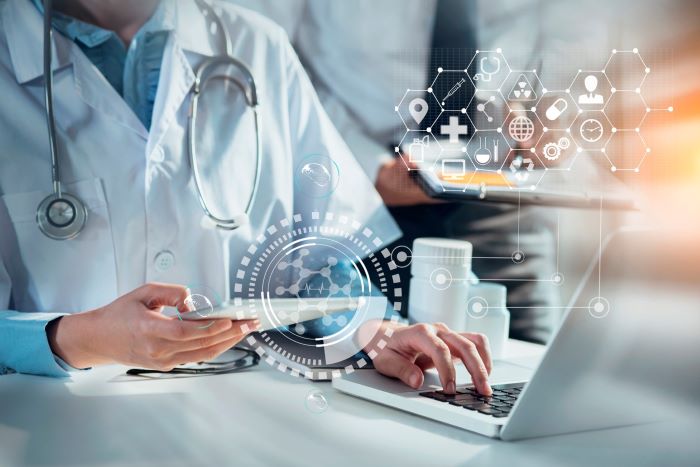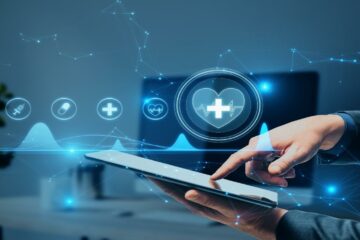How are technological advances improving our healthcare system?

Technology is having a profound impact on healthcare in the United States and around the world. Thanks to small devices, such as wearables, and cutting-edge diagnostic aids, such as health informatics, it is possible to prevent illnesses and create kinder, more effective treatments. As well as being effective in terms of patient care, technologies must be accessible and practical so that they can translate seamlessly into a clinical situation.
Keeping clinicians updated
To ensure they are ready to harness the power of technologies that can help them treat patients, clinicians are taught a range of proficiencies as part of their studies. The Walsh University online MSN FNP offers a diverse curriculum that includes expert tuition in the latest innovations, as well as clinical experience. This patient-centered course can be completed in two years and is an affordable, flexible choice for working nurses, especially for those interested in recent healthcare innovations.
Numerous innovations have already been adopted in hospitals, clinics, and physicians’ offices across the nation, while others are in the process of being rolled out.
Here are some of the many healthcare technologies currently pushing the limits of healthcare provision.
AI assists with diagnosis and treatment suggestions
Artificial intelligence is a global technology with applications in almost every industry. In healthcare, it can gather, collate, and process huge amounts of data drawn from patient records, surveys, research projects, and more. The reports it produces can be used to better understand the condition of a patient, give a possible diagnosis and suggest a treatment plan. Although a doctor’s intuition will always be essential in patient care, AI uses machine learning to sift through information and test and retest outcomes to learn more about an illness or the individual patient.
AI is also used to detect tiny patterns or changes in scans such as mammograms or chest X-rays. This can lead to a swifter and more accurate diagnosis of breast and lung cancer. It’s not just a better option for the patient – who is treated more quickly – but also for the facility, as it is more efficient than conducting biopsies to test for the presence of cancer cells.
3D printing creates precision prosthetics
Over 113 hospitals in the United States have a 3D printer in their facility. Using these machines, they can create custom-made replacements for joints, dental implants, and other types of prosthetics. In the future, 3D printers could also be used to produce human organs for transplants, as well as skin tissue. These products are strong and lightweight, but the key benefit for patients is that they are designed to fit perfectly with their individual anatomy. This makes wearing and interacting with the new item a far more comfortable experience. Furthermore, as so many 3D printers are in-house, it is cheaper for hospitals to create these products, and the lead times are short. To protect each patient from the risk of infection, 3D parts can be sterilized, even those with extremely high levels of complexity.
Virtual reality guides clinicians through surgery practice
Virtual and augmented reality are global technology trends used to educate patients, improve surgery outcomes, and treat mental health problems in a medical context. The nature of VR means physicians can use it to view inside and around the body, gaining the kind of in-depth access which would otherwise not be possible. This can be combined with realistic CGI or computer-generated image models that can be shown to patients. This enables a clinician to explain more clearly to a patient what is wrong and how the treatment plan will take effect.
VR is also a useful tool in medical training, as it allows students to visualize human anatomy and simulate surgical procedures to advance their learning. VR can also replicate an experience that a patient with PTSD finds stressful, then allow them to take part in the situation in a controlled way. This means a range of disorders can be treated from the comfort and comparative safety of a consulting room.
Smart pills provide a snapshot of the digestive tract
Smart pills are biometric scanners that are small enough to be swallowed by a patient. In many cases, they help a hospital to avoid carrying out an invasive procedure to investigate a patient’s condition. This is preferable for the patient, who does not have to experience the discomfort of an operation or the recovery period, but it also saves the facility time and money. The pill transmits the information it gathers in real time, using wireless communication, but there is an onboard memory – so some can also have long-term applications.
To ensure patient uptake remains high and smart pills are easy to use, they are designed to look like a standard capsule. Inside, they have a series of image, chemical, and biological sensors, so as they travel through the digestive system, they can collect important data before being expelled. They are most frequently used to diagnose gastrointestinal disorders and, in the future, they are expected to replace endoscopies. They also offer a less invasive form of colon exam for people who are nervous or those with bleeding problems.
How telehealth and telemedicine benefit patients and clinicians
During and after the COVID-19 pandemic, the use of telehealth to facilitate virtual appointments soared. It’s not just about a patient speaking with a practitioner from their home. Telehealth is better understood as a process that is made up of computers, smart gadgets, and wearable sensors. In combination, these devices monitor a person’s symptoms and help them to manage their condition independently. This technology is closely linked to telemedicine, in which doctors remotely diagnose a condition and arrange treatment over the phone or during a video call.
The use of these systems in combination is ideal for supporting people with long-term conditions, such as heart disease or chronic obstructive pulmonary disorder. As the patient can avoid visiting a busy hospital, they are less likely to pick up a life-threatening infection. Furthermore, by using telehealth and medicine in combination, clinicians can assist their patients with self-managing their symptoms after they’ve been discharged from the hospital. This can help to manage the problem of readmissions and reduce waiting times.
The Internet of Medical Things enhances patient safety
Like the IoT, which connects household appliances, like fridges, clocks, and ovens to a Wi-Fi network, the Internet of Medical Things (IoMT) connects medical equipment. It combines devices with sensors to perform actions or collect information, which is processed and sent through a network. This data is picked up and used by medical professionals to diagnose, track and monitor a range of conditions. The most commonly used IoMT solutions include smart beds with sensors that monitor patients and automated disinfecting products, which clean handles, surfaces, and objects automatically and then notify a user through a dashboard that the process is complete. The IoMT is also in use outside of hospitals. Linked gadgets can function as tracking devices for patients being moved or as a monitoring system that records a patient’s metrics in a non-medical setting.
Cloud computing safely stores and shares patient records
Many hospitals in the US are now storing patient records on the cloud. This means the vast amount of data generated each day is collected in a virtual environment. Therefore, the hospital can save money on the software and hardware it would usually use to maintain it. Furthermore, there is less risk of losing data in the event of a cyber incursion and having no system to back it up. Moreover, digital records are simpler to access than paper patient records, as they are always available from the linked dashboard on a clinician’s tablet. This makes it easier to share information during collaborative work and, as a result, can lead to a swifter diagnosis.
Personalized medicine delivers a customized treatment plan
Personalized medicine has been enabled through human genome research. It involves using information gleaned from an individual’s DNA profile to get a faster diagnosis and provide tailor-made treatments. These treatments are highly specialized and focus on the right solution for each patient – in terms of effectiveness and creating fewer side effects. It can also be used in ways other than simply tackling an illness once it takes hold. By bringing together data about a person’s genome, with other medical information, the technology can search for patterns. This means it can predict the likelihood of an individual developing specific diseases or act as an early warning system.
Changing the delivery of healthcare
Technology has had and continues to have a transformative effect on the healthcare sector. Although these tools and innovations will always function as collaborations with human clinicians, they are allowing these professionals to tackle some of our most pressing health problems. Their efficiency means healthcare can be delivered in a more cost-effective and accessible way, while their precision means diseases are diagnosed and treated quickly. As a result, practitioners have the opportunity to excel in their field, and patients can expect better outcomes and faster recovery times.










